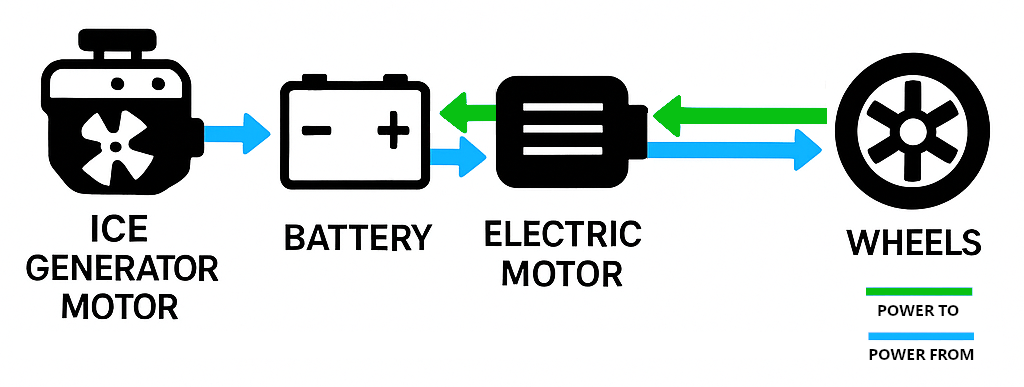Introduction
Electric and hybrid vehicles are becoming household names, but many buyers feel overwhelmed by technical jargon. This guide breaks down the most common drivetrains—series, parallel, power-split hybrids, FCEVs—using clear explanations and custom diagrams to demystify each one. Whether you're commuting in the city or exploring off-grid adventure, understanding these systems is key to making an informed decision.
Series Hybrid Drivetrain
How it works:
The ICE - Internal Combustion Engine does not drive the wheels. The ICE acts as a generator only that charges the battery.
The battery delivers power to the electric motor; that drives the wheels. Energy is returned to the battery through brake regeneration
Strengths:
Considerations:
Real-world example:
Nissan e-Note E-Power

Parallel Hybrid Drivetrain
How it works:
Both engine and electric motor are mechanically linked to the wheels via clutches and transmission; either or both can propel the vehicle.
The ICE acts as a generator charging the battery and the battery is also charged via brake regeneration
Strengths:
-
Great flexibility—electric for low speeds, engine for highway
-
Efficient highway performance with engine assistance
Considerations:
Real-world example:
Toyota Aqua Hybrid
Plug-In Hybrid Electric Vehicle (PHEV)
How it works:
Full hybrid drivetrain plus a larger battery that can be externally charged. Drives in full EV mode until battery depletes, then switches to hybrid mode.
The ICE acts as a generator charging the battery and the battery is also charged via brake regeneration
Strengths:
Considerations:
Real-world example:
Mitsubishi Outlander PHEV
Battery Electric Vehicle (BEV)
How it works:
No internal combustion engine—battery powers motors directly with inverters.
Battery energy is supplied by plug charge only, no ICE motor charging
Strengths:
Considerations:
Real-world example:
Nissan Leaf
Fuel Cell Electric Vehicle (FCEV)
How it works:
Hydrogen reacts in a fuel cell to generate electricity, powering electric motors; emits only water vapor.
Strengths:
Considerations:
Real-world example:
Toyota Mirai
Choosing the Right Drivetrain
-
Urban commuting? Series hybrids, BEVs and PHEVs shine with stop-and-go efficiency.
-
Highway travelers? Parallel Hybrids, PHEVs and Big Battery BEVs offer superior long-distance performance.
-
Zero emissions priorities? BEVs or FCEVs are best—just check availability of charging or hydrogen infrastructure.
-
Budget & incentives: BEVs may have higher price tags, but offer long-term cost savings and tax credits. Hybrids and PHEVs balance cost and convenience.
Conclusion
From efficient city-running series hybrids to emission-free BEVs and hydrogen-powered FCEVs, each drivetrain offers its unique perks and trade-offs. Your choice ultimately depends on driving habits, charging/refueling options, and budget. For a firsthand experience, visit our EV Experts at GVI—see each drivetrain in action and get expert guidance. View our selection of Hybrid and Electric Vehicles for sale www.gvi.kiwi


